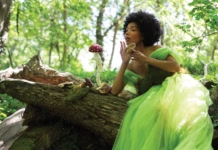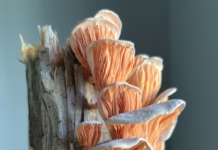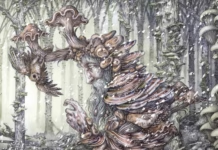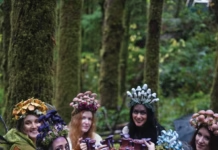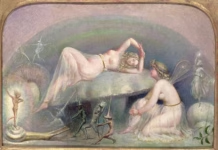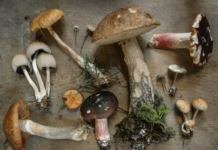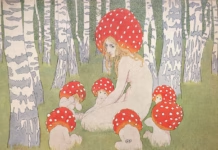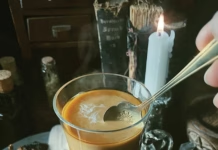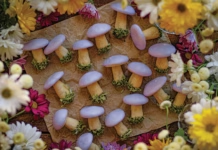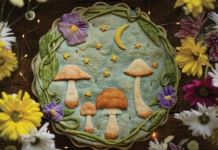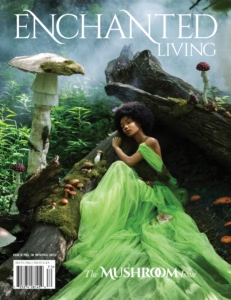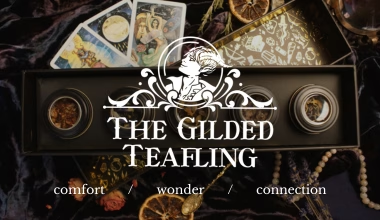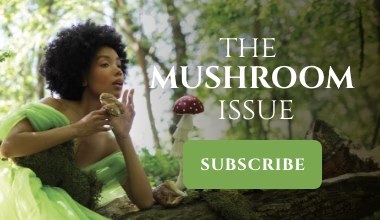Renowned mycologist Paul Stamets is, simply put, mad about mushrooms. From tame little grocery-store white buttons to flamboyant foraged chanterelles, there isn’t much that Stamets doesn’t know about the funky fungi. A recently discovered species of magic mushroom has even been named after him: Psilocybe stametsii, which was unearthed in a cloud forest in Ecuador.
Stamets is the author of Mycelium Running: How Mushrooms Can Help Save the World and the forthcoming Psilocybin Mushrooms in Their Natural Habitats, and he has delivered brilliant talks for TED and TEDMed. He’s devoted his life to studying and sharing the magic of mushrooms, yet he’s barely gotten started. That’s because there is just so much to learn—culinarily, medicinally, nutritionally, spiritually, and beyond.
Mushrooms are especially good at building things up and breaking them down. The root structure of mushrooms— mycelium—is so strong that it’s being used to build bricks that might eventually be used to construct buildings. At the same time, through a process called mycoremediation, mycelium breaks down pollutants, pesticides, heavy metals, even radiation in the soil. Mushrooms are scavengers—their entire raison d’être is to digest and decompose other plants—which makes them a rich source of vitamins, enzymes, and active compounds that are being studied to cure disease. When it comes to human and environmental health, the curative possibilities, Stamets says, are potentially limitless.
Mushrooms are creepy, delicious, poisonous, and profound—but mostly miraculous. We talked to Stamets to find out more.
What first attracted you to mushrooms?
My parents warned me about wild mushrooms—that they were dangerous. Yet our family loved button mushrooms. I was always curious about my parents’ fears and was attracted to the study of this “forbidden fruit.”
Why do you think mushrooms have become so popular nowadays? And why should our readers be excited about mushrooms now?
There is a confluence of positive realizations about mushrooms: so many colorful species, so many delicious edibles. Taking family field trips into the woods has centered families in shared positive experiences. Mushrooms also help the immune system and are packed with antioxidants. They can support nerve health. In addition, the research surrounding psilocybin mushrooms has opened up so many new eyes to this exciting yet understudied field of science.
Moreover, the art world has rediscovered mushrooms, as well as the film community. [Stamets was featured in the documentary film Fantastic Fungi, by award-winning cinematographer, director and producer Louie Schwartzberg; along with best-selling author Michael Pollan, Dr. Andrew Weil, Timothy Leary, and others.]
You recently recommended a beautiful fungal lunar calendar designed by artist Grace Ng Dung, as well as some of Heather Brooks’s mushroom collages. [Her art site, Small Woodland Things, is also featured in this issue.] Can you talk about other mushroom-related art you’re enjoying right now?
I’m a big fan of Alex and Allyson Grey, Autumn Skye, Mark Hansen, and many others. I love artists who accurately portray mushrooms. It tells me these artists are not only skilled in painting but know the subject matter personally. They have my great respect.
What are some of the most exciting developments in mycology?
Mushroom mycelium is beneath every footstep you take. It influences and can support the immune systems of diverse animals and plants. Mushroom mycelium is the immune system of the mushroom life cycle, and we can tap into these immunologically active networks to potentially help our health. There is preliminary cutting-edge research showing that mushroom mycelium of turkey tail and agarikon, grown on grain, can support innate immunity. While this study is pending publication, the results are very exciting.
What might surprise our readers the most to learn about mushrooms?That about 90 percent of them have not yet been identified!
How do strangers react when you tell them what you do?
They used to avoid me and the subject. Now they’re excited to speak to me, from children to grandparents. Everywhere I go, people approach me with smiles, curiosity, respect—and often a wink!
What are some of the best mushrooms to include in your diet and why?
Foodwise: shiitake, maitake, oysters, enoki, porcini, truffles, and pine mushrooms. For support of immunity and cognitive health: turkey tail, agarikon, reishi, chaga, and lion’s mane.
Do you forage for mushrooms?
Yes! Every day as I walk. My favorites are pine mushrooms, hedgehogs, chanterelles, winter chanterelles, porcini, oysters, lobsters, and candy caps for culinary purposes; turkey tails and ganodermas for health supporting purposes; cyans and liberty caps for spiritual purposes.
But it is the wide range of colors, forms, and mysterious species that excite me. I don’t have to pick them to enjoy them.
One of the most common revelations for those new to this subject—often students of mycologists—is that they had no idea how diverse and beautiful mushrooms are, and that they’re everywhere. I often hear them question themselves: “How could I not have noticed them before?”
What advice can you share for other foragers?
Join a mycological society. See namyco.org for a national and international registry.
How do you stay enchanted?
Mushrooms and mycologists build bridges across cultures, religions, politics, and generations. They bring us together, and the excitement, the eureka moment, is a shared experience in wonder, delight, science, and comradery. Mushrooms, particularly psilocybin mushrooms, make us nicer people—and smarter too!
When you say that “mushrooms and mycologists build bridges across cultures, religions, politics and generations,” what do you mean? Throughout the world, people have discovered mushrooms, and through trial and error, they have come to know which mushrooms are safe to consume and which ones are not. Moreover, many polypore mushrooms like turkey tails have been used for enhancing health by making teas or used, as in the case of some Native Americans, as a chewing gum for dental health.
When people from one region of the world travel to new lands, they bring that cultural myco-knowledge with them. A good example is the popularity of the pine mushroom, a.k.a. matsutake. In the 1970s, few Americans of European descent consumed these mushrooms.
I joined a mycological society around 1975, and our Japanese members brought these mushrooms to our attention. They relished in the fact we had not awakened to them in the Pacific Northwest, as competition for finding them in Japan was fierce, and indeed a “national sport.” The French and Italian cultures helped bring our attention to boletus (ceps, porcini). From Mesoamerica to Russia to South Africa, many cultures have deep love for mushrooms. These are just a few examples of mushrooms bridging cultures across continents. As humans migrate, mycological knowledge is shared and spread.
To learn more about Stamets’s work, visit fungi.com, hostdefense.com, instagram.com/paulstamets, facebook.com/paulstamets, youtube.com/paulstamets, and listen to his TED and TEDMed talks on YouTube.
Note: The statements made throughout this article have not been evaluated by the U.S. Food and Drug Administration and are not intended to diagnose, treat, cure, or prevent any disease.




